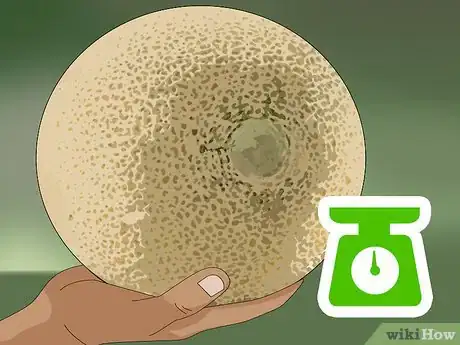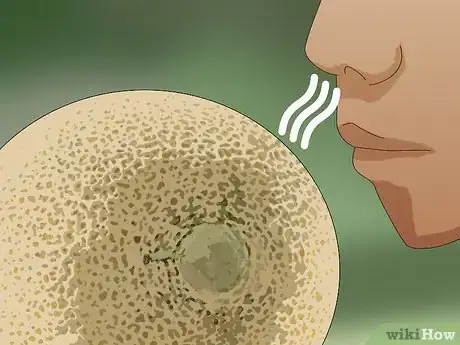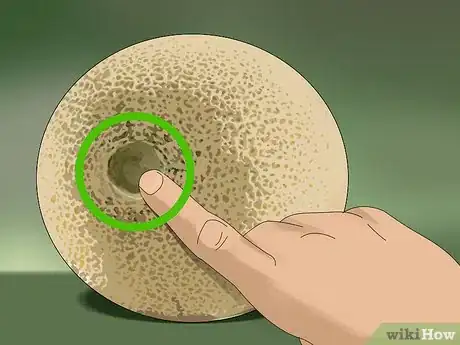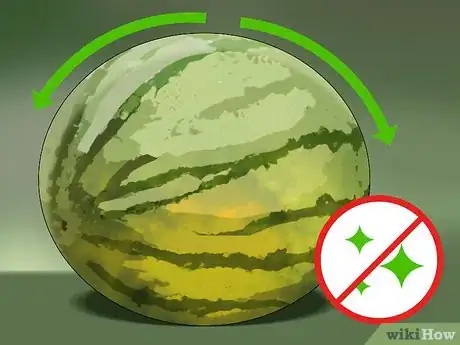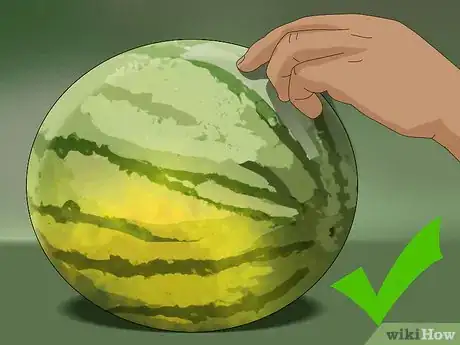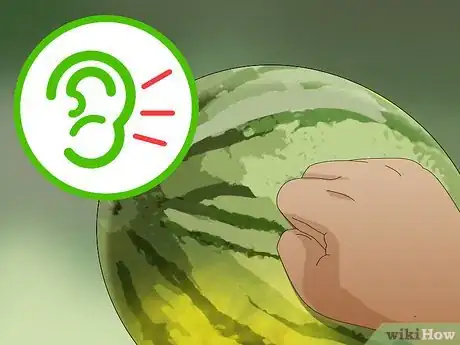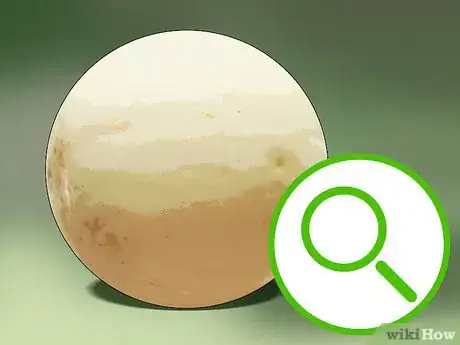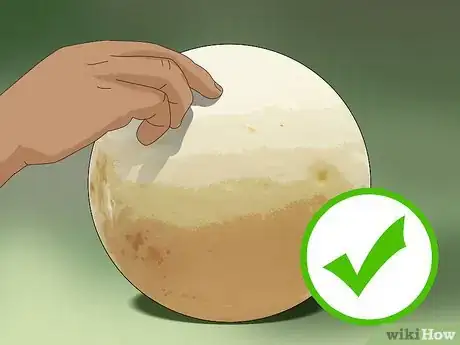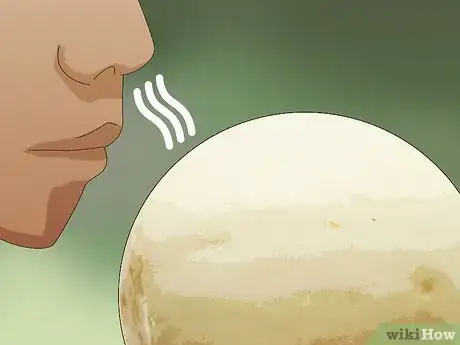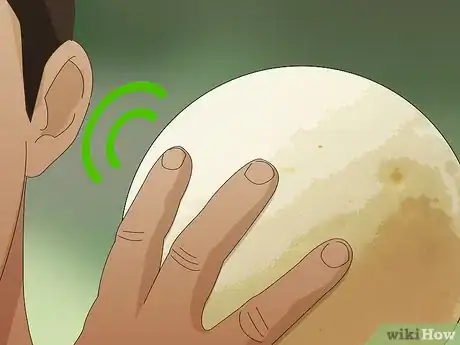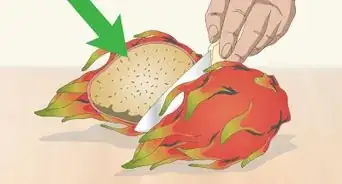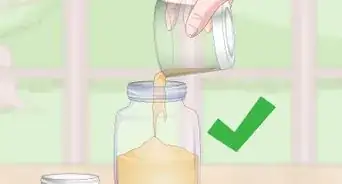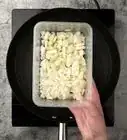This article was co-authored by wikiHow Staff. Our trained team of editors and researchers validate articles for accuracy and comprehensiveness. wikiHow's Content Management Team carefully monitors the work from our editorial staff to ensure that each article is backed by trusted research and meets our high quality standards.
This article has been viewed 157,635 times.
Learn more...
When they're all stacked in a heap at the grocery store or farmer's market, choosing a delicious, ripe melon can seem like mission impossible. But no one wants to go home and slice into their fruit only to find that they've spent their money on a mushy, inedible melon. Fortunately, there are ways to tell if a melon is ripe without cutting into it, so whether you like cantaloupes, watermelons, or honeydews, you can always wind up with tasty fruit.
Steps
Choosing a Cantaloupe
-
1Examine the cantaloupe’s color and texture. A good, ripe cantaloupe will have a base color that’s tinted gold, so avoid those that appear green. The skin shouldn’t have any tears or scars, and the netting on its surface should be thick, coarse, and strongly defined.
- If the cantaloupe’s base color still has a greenish tint, that usually means that it isn’t ripe yet.
- It’s normal for the netting on the cantaloupe’s skin to be more pronounced in some areas than others.
-
2Test the cantaloupe’s weight. Once you’ve found a cantaloupe with skin that appears healthy, pick it up and test its weight. The melon should feel fairly heavy for its size.
- To determine whether it is a good weight, you may have to test several cantaloupes from the store’s display. That will help you determine if one in particular feels heavy enough.
Advertisement -
3Smell the cantaloupe. One of the best ways to determine if a cantaloupe is ripe and healthy is to smell it. If the melon has a sweet, musky scent, it’s likely ripe and a good one to bring home.
- Smell the cantaloupe at the blossom end to test for ripeness. That’s the end of the melon that’s opposite the stem area.
- If the cantaloupe smells perfume, that may be an indication that it’s overripe.
-
4Check out the cantaloupe’s end stem. Finally, before purchasing a cantaloupe, examine the stem area. Make sure that there aren’t any tears in the skin, as these can sometimes mean that the melon was harvested too early. There should also be a slight indentation in the stem area to show that the cantaloupe separated easily from the vine when it was harvested.
- The stem itself shouldn’t be attached to the cantaloupe. That usually indicates that the melon hasn’t matured.
- Avoid any cantaloupes that are soft or moist in the stem area.
Selecting a Watermelon
-
1Look for a watermelon with dull skin and a uniform shape. While a watermelon should be a bright green color, its skin shouldn’t be shiny. Instead, look for one with skin that’s slightly dull. It should also have a uniform shape to indicate that it’s matured fully.[1]
- If a watermelon’s skin is shiny, it may indicate that the melon isn’t ripe.
-
2Find a watermelon with a creamy patch on the underside. Next, pick the watermelon up and examine the bottom. There should be a creamy yellow spot from where the melon rested on the ground as it was growing. This field spot indicates that the watermelon spent plenty of time in the sun maturing instead of being harvested too early.[2]
- The deeper the color of a watermelon’s field spot is the sweeter the melon will be. A white spot is fine, but a yellow spot is best.
-
3Check the texture of the watermelon’s skin for bumps and dents. As you’re holding the watermelon, run your fingers along its skin to examine the texture. There shouldn’t be any dents, bumps, or irregular curves, which can indicate that the melon didn’t get regular sun and water as it grew. Instead, choose a smooth, even melon.[3]
- Make sure that there aren’t any cuts or scars in the watermelon’s skin either.
-
4Test the watermelon’s weight. With the watermelon in your hands, make sure that it has a good weight. It should feel heavy for its size, so compare it with another melon that’s a similar size to see if it has a good heft to it.[4]
-
5Tap your knuckles against the watermelon. Finally, hold the watermelon a couple of inches from your ear and knock on it with your knuckles. If the melon is ripe, it should make a hollow, tenor-like sound.[5]
- The knocking test shouldn’t be used as the only test for ripeness because not all watermelon farmers agree that it is accurate. Overripe watermelons can sometimes make the same sound as ripe fruit. Use it to confirm that a melon that meets all of the other criteria is ready to bring home.[6]
- If the watermelon makes a thudding sound when you hit it, it is likely still full of water and not yet ripe.
Picking Out a Honeydew
-
1Examine the honeydew’s skin for a rich, creamy color. A healthy, ripe honeydew will be a cream, yellow, or gold color. Avoid melons that are overly green because they aren’t ripe yet.[7]
- If you choose a honeydew that’s a creamy white color, it won’t be ripe yet but will ripen if you leave it out at room temperature for a few days.
-
2Choose a symmetrical honeydew. A healthy ripe honeydew will have a spherical shape. More important than looking at the shape, though, is to make sure that the melon you choose is symmetrical. If one end is larger than the other, it can indicate that the honeydew didn’t grow evenly and probably isn't the best choice.[8]
-
3Feel the honeydew’s skin. Run your fingers along the skin of the honeydew to examine its texture. It should have a smooth, velvety feel with no noticeable dents or bumps.
- It’s also normal for a honeydew’s skin to have a slightly waxy feel because the sugar in the melon rises to the surface as it ripens.
-
4Check the honeydew’s scent. Just as with a cantaloupe, you can usually tell if a honeydew is ripe by sniffing it. It should give off a sweet, pleasant scent.
- A honeydew’s scent will be most evident when the melon is at room temperature.
-
5Shake the honeydew and listen to the sound. Finally, before purchasing a honeydew, shake it gently. If you hear the seeds rattling around inside, the melon is ripe. If you shake the honeydew and it sounds soupy or slushy inside, that likely means it’s overripe.
Community Q&A
-
QuestionHow can I tell if a pineapple is ripe?
 Community AnswerIf you can pull the leaf out with ease, it's ripe and sweet. If it takes effort, it's not ripe yet.
Community AnswerIf you can pull the leaf out with ease, it's ripe and sweet. If it takes effort, it's not ripe yet. -
QuestionHow do I slice a honeydew?
 Community AnswerFor slicing a honeydew, your best is slicing it in wedges so most of the juice stays inside the fruit. And of course, this way is easier to eat.
Community AnswerFor slicing a honeydew, your best is slicing it in wedges so most of the juice stays inside the fruit. And of course, this way is easier to eat.
References
- ↑ http://www.nytimes.com/2010/08/18/dining/18melonside.html?_r=1
- ↑ http://www.nytimes.com/2010/08/18/dining/18melonside.html?_r=1
- ↑ http://www.nytimes.com/2010/08/18/dining/18melonside.html?_r=1
- ↑ http://www.nytimes.com/2010/08/18/dining/18melonside.html?_r=1
- ↑ http://www.foodchannel.com/articles/article/how-pick-good-watermelonand-other-watermelon-tidbi/
- ↑ http://www.whataboutwatermelon.com/index.php/2009/05/how-to-choose-the-right-watermelon/
- ↑ http://www.theproducemom.com/2016/03/19/honeydew-how-to-select-store-serve/
- ↑ http://www.theproducemom.com/2016/03/19/honeydew-how-to-select-store-serve/
About This Article
To choose a melon, examine the outside of the fruit first. If you’re choosing a cantaloupe, look for one that’s tinted gold, with thick, coarse netting on the surface of the skin. A watermelon should be a bright green color with a dull skin and a uniform shape. To pick a honeydew, look for a melon with a rich yellow, cream, or gold color and a symmetrical shape. Whichever type of melon you’re choosing, the fruit should feel heavy for its size, which indicates that it’s fully ripe. If you want to learn more, like how to check the melon's weight and texture, keep reading the article!

